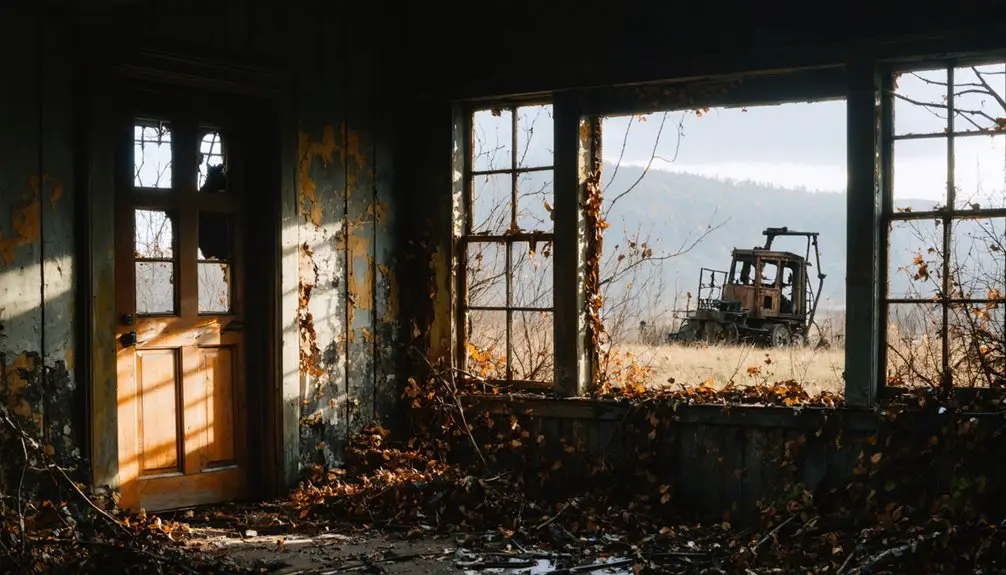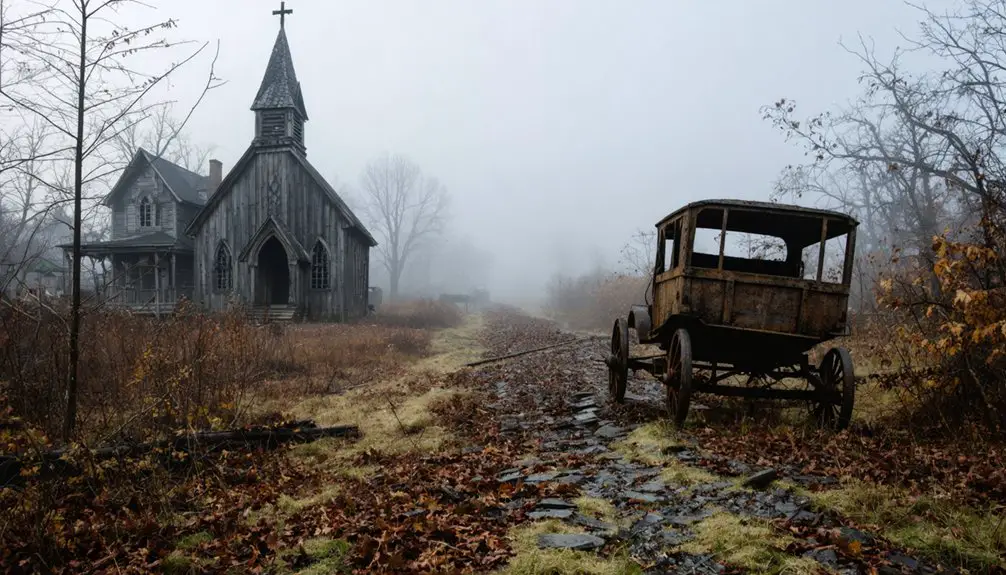You’ll find Blackwood, Pennsylvania in the historic Blacklick Valley, where it emerged as a coal mining town in 1903 under the Penn Virginia Corporation. The community thrived through the mid-20th century, supported by railroad networks and lumber operations, until mine closures and resource depletion led to its abandonment by the 1980s. Today, the ghost town’s legacy lives on through its environmental impact, including acid mine drainage that continues to affect local waterways – a stark reminder of Pennsylvania’s complex industrial past.
Key Takeaways
- Blackwood emerged as a prosperous coal mining community in the mid-1800s before declining due to coal seam depletion and mine closures.
- The town’s economic foundation crumbled after railroad operations ceased and mining jobs dropped dramatically from 72,624 to 952.
- Environmental damage from mining operations left toxic AMD pollution in Blacklick Creek, with water acidity 100,000 times above neutral levels.
- Established in 1903 under Penn Virginia Corporation, Blackwood’s infrastructure and community life centered around company-provided facilities.
- Population decline accelerated after industrial collapse, transforming the once-thriving mining town into a largely abandoned community.
Origins and Settlement in the Blacklick Valley
While Native Americans had long inhabited the Blacklick Valley region, with archaeological evidence revealing both Archaic and Late Woodland village sites throughout the Conemaugh-Blacklick watershed, European settlement didn’t begin until William Bracken’s 1786 land purchase of 309 acres from Pennsylvania.
You’ll find that the Shawnee and Delaware tribes first utilized Blacklick Creek, though written records are scarce. The area marked a cultural boundary between Late Woodland groups influenced by Monongahela and Upper Allegheny Valley cultures. David and Penny Russell later donated this historically significant land to Indiana County Parks in 1995.
When early settlers arrived, they faced significant challenges, including raids that forced them to seek refuge at Fort Wallace in 1777. The first successful squatters obtained their land warrants in spring 1769, establishing permanent claims to the territory. The region’s first European communities included Belsano, founded in 1830, while Irish immigrants from Derry and Cumberland Valley migrants established homesteads throughout the area.
The Rise of Coal and Lumber Industries
As Pennsylvania’s industrial revolution gained momentum in the mid-1800s, Blackwood emerged as a significant hub for both coal mining and lumber production.
You’ll find that industrial demand for bituminous coal skyrocketed with the rise of coke-fired blast furnaces, while the lumber supply from surrounding forests proved essential for mine construction and railroad development.
Companies like the Blackwood Coal and Coke Company capitalized on this boom, creating a symbiotic relationship between the two industries. Like the successful Lehigh Coal and Navigation Company, Blackwood’s enterprises managed both mining operations and transportation infrastructure.
The timber you’d see harvested supported mine operations through shoring and ventilation infrastructure, while also providing materials for coal transport via railroad ties and canal boats. The completion of the Sandy Run Branch in 1876 by the Huntingdon & Broad Top Railroad significantly expanded transportation capabilities in the region.
Pennsylvania’s timber industry fueled mining operations, with wood supporting vital mine infrastructure and transportation networks across the region.
This dual economic engine attracted workers and their families, transforming Blackwood into a thriving settlement where coal miners and lumbermen often shared overlapping roles in building the region’s industrial might.
Railroad Networks and Economic Growth
When the Pennsylvania Railroad (PRR) established its operations in 1846, you’d find it revolutionized regional connectivity through an extensive network linking Philadelphia, Harrisburg, Altoona, Johnstown, and Pittsburgh.
The railroad expansion transformed Pennsylvania’s economic landscape, with engineering marvels like the Horseshoe Curve and Gallitzin Tunnels conquering mountain terrain to connect east and west. The PRR grew into the largest railroad corporation in the world by 1882, demonstrating its dominance in American transportation.
You’ll discover how this economic connectivity sparked tremendous growth across the region:
- Towns like Altoona emerged as crucial railroad hubs with maintenance facilities
- Small rail stops, including Blackwood’s 1889 station, grew into thriving communities
- Industries beyond coal and lumber flourished with new market access
- The rail network accelerated business operations, moving millions in freight and passengers
The Pennsylvania-Reading Seashore Lines later became a key player in regional consolidation by 1932, merging several southern New Jersey railroad operations.
Local infrastructure investments, including Blackwood’s station, reflected the PRR’s commitment to thorough regional development.
Environmental Impact and Resource Depletion
While you’ll find remnants of mining waste and acid drainage around Blackwood’s abandoned coal operations, the most concerning pollution comes from the remaining coal refuse piles that continue leaching toxins into nearby streams.
Similar to the place name disambiguation issues seen with other abandoned mining towns, the surrounding forest’s recovery timeline spans decades, with native vegetation slowly reclaiming disturbed areas where mine spoils once dominated the landscape.
The watershed contamination affects local aquatic ecosystems, as heavy metals and acidic runoff from former mining sites flow into tributaries of the Schuylkill River system, creating long-term water quality challenges for downstream communities. Like Centralia’s infamous underground coal fire, these environmental hazards pose ongoing risks that could persist for centuries to come.
Mining Waste and Pollution
The environmental legacy of coal mining in Blackwood has left a devastating footprint on Pennsylvania’s ecosystem, with over 3,300 miles of streams suffering from Acid Mine Drainage (AMD).
You’ll find extensive coal refuse piles releasing toxic runoff laden with iron, manganese, and aluminum, devastating aquatic life. Pennsylvania’s 70 coal ash dumpsites pose ongoing threats to environmental and human health across the state. The state requires over $4.9 billion to fully reclaim and clean up its abandoned mine sites.
While mining regulations have improved through legislation like the Coal Refuse Disposal Control Act, many abandoned sites remain challenging to address due to access issues and private ownership complications.
- Coal refuse sites continue leaching acid drainage through chemical oxidation, maintaining deadly low pH levels in nearby waters.
- Unlined coal ash ponds threaten groundwater with arsenic, cadmium, and other heavy metals.
- Pollution remediation efforts have shown 97% reduction in key pollutants where implemented.
- Sediment and silt from unstable waste slopes further damage water clarity and aquatic habitats.
Forest Recovery Timeline
As Pennsylvania’s forests endeavor to recover from decades of mining activity, you’ll find a complex regeneration process that typically spans 50 to 75 years before reaching pre-disturbance conditions.
You’re witnessing nature’s resilience through seed dispersal and sprouting, though several challenges threaten ecological balance. The region’s high deer populations pose a significant risk, with studies showing over 50% of oak/hickory stands struggling to regenerate due to excessive browsing.
Forest regeneration faces additional hurdles from invasive species and the devastating impact of Hemlock Woolly Adelgid, which has caused up to 90% mortality in some areas.
While biological controls and chemical treatments offer hope, you’ll need to take into account that sustainable recovery requires careful monitoring, professional forestry guidance, and long-term management strategies to guarantee successful reestablishment of native species.
Watershed Contamination Effects
Mining operations near Blackwood have inflicted devastating impacts on local watersheds, with Blacklick Creek suffering severe contamination from acid mine drainage (AMD).
You’ll find water acidity levels 100,000 times stronger than neutral, decimating watershed health and destroying aquatic ecosystems. The rusty orange sediment you see coating the creek bed comes from oxidized iron deposits, while aluminum and manganese levels have reached toxic concentrations.
- AMD’s persistent nature means some mines continue polluting for over 2,000 years
- Contaminated groundwater infiltrates connected surface waters, extending damage downstream
- Heavy metals bioaccumulate through the food chain, eliminating essential macroinvertebrates
Despite $25 million allocated for pollution mitigation, restoration remains challenging due to continuous groundwater discharge.
The devastating effects ripple throughout the entire watershed, depleting clean water resources and creating long-term environmental damage.
The Path to Abandonment
As coal seams depleted and environmental regulations tightened in Pennsylvania, you’d see Blackwood’s mines shutting down one by one, leaving the majority of residents without employment.
The closure of the railroad lines that once transported coal and connected the town to broader markets dealt another devastating blow to the local economy.
With their primary sources of income gone, working-age residents were forced to relocate in search of jobs elsewhere, triggering a rapid population decline that would ultimately transform Blackwood into a ghost town.
Industrial Jobs Vanish
While Blackwood’s industrial fortunes initially rested on anthracite coal, the town’s economic foundation began crumbling after World War II when multiple industries collapsed in succession.
You’d witness massive job displacement as coal production plummeted from 44 million tons in 1950 to under 2 million by 2016, with mining jobs in Schuylkill County dropping from 72,624 to just 952.
The economic decline accelerated as steel plants, like Alan Wood Steel’s Conshohocken facility, shut down in 1977.
- Traditional manufacturing sectors including textiles, glass, and lumber withered under foreign competition
- Highway transportation replaced rail systems, isolating towns dependent on industrial freight
- Automation eliminated many remaining factory positions
- Re-mining operations couldn’t replace the thousands of lost coal industry jobs
Population Flight Accelerates
Once the industrial backbone crumbled, Blackwood’s population entered a devastating spiral of decline that you’d see most dramatically in Centralia, where residents fled from a catastrophic 1962 coal mine fire.
From 1,000 residents in 1980, you’d find only 4-5 people remaining by 2020, as government-mandated evacuations and buyouts forced most to relocate.
You’ll notice how community fragmentation intensified when Pennsylvania’s Department of Environmental Protection exercised eminent domain in the 1980s.
Those who stayed clashed with departed neighbors, while population decline triggered widespread closures of local businesses and services.
The town’s identity shifted from a thriving coal community to an isolated outpost where remaining residents faced limited services, deteriorating infrastructure, and the psychological burden of living in a semi-abandoned place.
Legacy in Pennsylvania’s Mining History

Through its pioneering role in Pennsylvania’s bituminous coal industry, Blackwood exemplified the economic and social transformation of early 20th-century mining communities.
Under Calvin Pardee’s leadership, the town’s cultural heritage became deeply intertwined with the broader story of American industrialization.
You’ll find that community resilience shaped Blackwood’s identity, from its company-provided infrastructure to its specialized workforce of miners, doctors, and law enforcement.
- Established in 1903, the Blackwood Coal and Coke Company operated as part of Penn Virginia Corporation’s extensive mining network
- The town’s self-contained community structure reflected the era’s typical company town model
- Company records spanning from the 1860s to 1980s document Blackwood’s significant industrial contributions
- The post office’s establishment in 1911 marked Blackwood’s growth into a thriving mining settlement
Frequently Asked Questions
Are There Any Paranormal Activities Reported in Blackwood’s Abandoned Buildings?
You’ll find documented ghost sightings in abandoned miners’ homes, where EVP recordings capture unexplained voices. Urban legends tell of spirits lingering in basements, often near old family photos and music boxes.
Can Visitors Legally Explore and Photograph the Remaining Structures Today?
You’ll need legal permissions to explore as most structures are on private property. While you can photograph from public roads, don’t trespass or venture inside buildings without owner consent.
What Happened to the Families Who Were Forced to Leave?
You’ll find displaced families scattered across Pennsylvania, facing economic hardship and loss of tight-knit community. Many preserved their community memories through oral histories while struggling to rebuild lives elsewhere.
Are There Any Remaining Valuable Artifacts or Resources Worth Excavating?
You won’t find an Instagram-worthy jackpot here. While basic mining equipment and household remnants exist, there’s no documented artifact significance worth the risky excavation techniques in this legally restricted, potentially hazardous area.
Which Specific Safety Hazards Should Explorers Be Aware of When Visiting?
You’ll face deadly risks from structural instability in abandoned mines, toxic gases from underground fires, sudden ground collapses, and hazardous materials in deteriorating buildings. Don’t explore without proper safety equipment.
References
- https://en.wikipedia.org/wiki/Ghost_Town_Village
- https://www.youtube.com/watch?v=Qj5LjacccJ0
- https://obscurevermont.com/centralia-pennsylvania-a-ghost-town-on-fire/
- https://www.youtube.com/watch?v=NcDbPf4pkCA
- https://www.youtube.com/watch?v=Fo1ey-BVri0
- https://www.pa-roots.com/westmoreland/oldwestmoreland/chapter18.html
- https://indianacountyparks.org/our-parks/blacklick-valley-natural-area/history-of-blacklick-valley-natural-area/
- https://pennarchcouncil.org/LegacyData/spgrant-2c.htm
- https://homepages.rootsweb.com/~pacamb/Blacklick_Township.html
- https://www.iup.edu/library/departments/archives/coal/coal-culture-timeline.html



